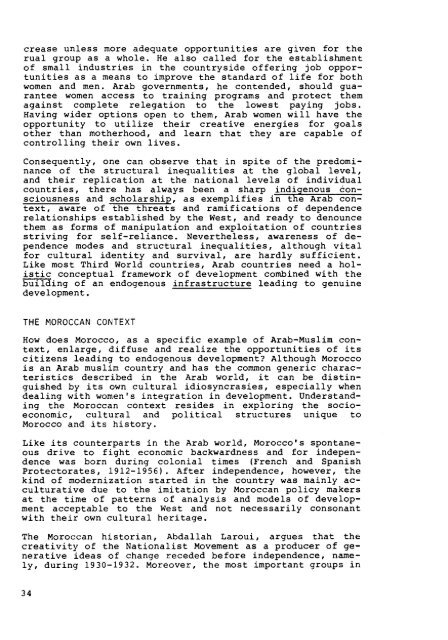Ifda dossier 47, May/June 1985
Ifda dossier 47, May/June 1985
Ifda dossier 47, May/June 1985
You also want an ePaper? Increase the reach of your titles
YUMPU automatically turns print PDFs into web optimized ePapers that Google loves.
crease unless more adequate opportunities are given for the<br />
rual group as a whole. He also called for the establishment<br />
of small industries in the countryside offering job oppor-<br />
tunities as a means to improve the standard of life for both<br />
women and men. Arab governments, he contended, should gua-<br />
rantee women access to training programs and protect them<br />
against complete relegation to the lowest paying jobs.<br />
Having wider options open to them, Arab women will have the<br />
opportunity to utilize their creative energies for goals<br />
other than motherhood, and learn that they are capable of<br />
controlling their own lives.<br />
Consequently, one can observe that in spite of the predominance<br />
of the structural inequalities at the global level,<br />
and their replication at the national levels of individual<br />
countries, the re has always been a sharp indigenous consciousness<br />
and scholarship, as exemplifies in the Arab context.<br />
aware of the threats and ramifications of deoendence<br />
relationships established by the West, and ready to denounce<br />
them as forms of manipulation and exploitation of countries<br />
striving for self-reliance. Nevertheless, awareness of dependence<br />
modes and structural inequalities, although vital<br />
for cultural identity and survival, are hardly sufficient.<br />
Like most Third World countries, Arab countries need a holistic<br />
conceptual framework of development combined with the<br />
building of an endogenous infrastructure leading to genuine<br />
development.<br />
THE MOROCCAN CONTEXT<br />
How does Morocco, as a specific example of Arab-Muslim con-<br />
text, enlarge, diffuse and realize the opportunities of its<br />
citizens leading to endogenous development? Although Morocco<br />
is an Arab muslim country and has the common generic charac-<br />
teristics described in the Arab world, it can be distin-<br />
guished by its own cultural idiosyncrasies, especially when<br />
dealing with women's integration in development. Understand-<br />
ing the Moroccan context resides in exploring the socio-<br />
economic, cultural and political structures unique to<br />
Morocco and its history.<br />
Like its counterparts in the Arab world, Morocco's spontane-<br />
ous drive to fight economic backwardness and for indepen-<br />
dence was born during colonial times (French and Spanish<br />
Protectorates, 1912-1956). After independence, however, the<br />
kind of modernization started in the country was mainly ac-<br />
culturative due to the imitation by Moroccan policy makers<br />
at the time of patterns of analysis and models of develop-<br />
ment acceptable to the West and not necessarily consonant<br />
with their own cultural heritage.<br />
The Moroccan historian, Abdallah Laroui, argues that the<br />
creativity of the Nationalist Movement as a producer of ge-<br />
nerative ideas of change receded before independence, name-<br />
ly, during 1930-1932. Moreover, the most important groups in
















